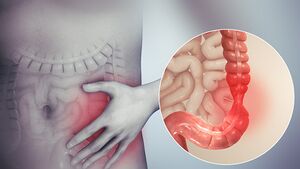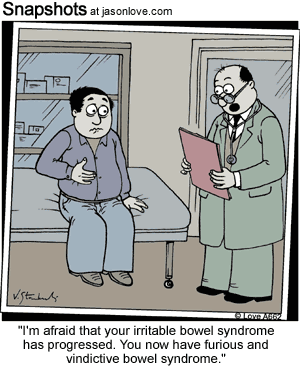Irritable Bowel Syndrome
Original Editors - Mary Page from Bellarmine University's Pathophysiology of Complex Patient Problems project.
Top Contributors - Mary Page, James Jolly, Admin, Hannah Wempe, Lucinda hampton, Kim Jackson, Elaine Lonnemann, WikiSysop, 127.0.0.1, Dave Pariser, Wendy Walker, Vidya Acharya and Manisha Shrestha
Introduction[edit | edit source]
Irritable bowel syndrome (IBS) is the most common disorder of the GI system, with symptoms predominantly including diarrhoea, constipation, or a combination of both. IBS is considered a functional disorder of motility in the small and large intestine, due to no detectable abnormality of the bowel [1].
Etiology[edit | edit source]
IBS cause remains unknown, despite concerted efforts find its etiology. Probably multiple factors are at play. Of late a very common protozoan called Blastocystis sp. has been seen as a risk factor, although the mechanism through which it may cause IBS yet to be found.[2]
Epidemiology[edit | edit source]
IBS is one of the most commonly diagnosed GI disorders with nearly 12 percent of patients who seek medical care in primary care practices being for IBS related complaints.[3][1]. Studies reveal a prevalence as high as 20%, dependant on the area of the world studied and the diagnostic criteria employed. In South America approximately 21% have IBS whilst in Southeast Asia at 7% have IBS.[2][4]
Clinical Presentation[edit | edit source]
GI symptoms associated with IBS are highly variable, normally intermittent and can include but are not limited to the following: [1]
- Painful abdominal cramps
- Constipation
- Diarrhoea
- Nausea and vomiting
- Anorexia
- Foul breath
- Sour stomach
- Flatulence
- Abdominal bloating
- White mucus in stool
Pain characteristics include a dull, deep discomfort with sharp cramps in the lower left quadrant of the abdomen. Abdominal pain normally occurs in the morning or after eating and is relieved by evacuation of the bowels[3]
Diagnosis[edit | edit source]
Because there are no physical signs or abnormalities associated with Irritable Bowel Syndrome, there are currently no definitive tests for diagnosis [3][5]. IBS symptoms are also seen in more dangerous bowel conditions doctors need to eliminate these before diagnosing IBS. Diagnosis is then usually based on patient history and two sets of symptom-based criteria:
- Rome III criteria—This criteria require the patient to have abdominal pain lasting at least three days a month in the last three months, associated with two or more of the following: [5] Improved pain with defecation; Altered frequency of defecation; Altered consistency of stool[5]
- Manning criteria—This criteria looks at the likelihood of IBS being present based on the following symptoms: Pain relieved by defecation; Incomplete bowel movements; Mucus in stool; Changes in stool consistency[5]
Additional tests include: Flexible sigmoidoscopy or Colonoscopy; Stool test; Blood tests to check for Celiac disease [5].
Management[edit | edit source]
IBS is a symptom-based disorder, and treatment aims are resolution of symptoms such as pain, bloating, cramping, and diarrhea or constipation habits. Treatment may include:
- For constipation, fibre supplements and laxatives
- For Diarrhea, medications such as loperamide or probiotics can be helpful
- Increased physical activity to increase colonic transport time and improve symptoms.
- Dietary Management. Eliminating foods that trigger symptoms is one of the most effective treatments for IBS. Common triggers being: High-gas foods—foods such as carbonated beverages, cabbage, broccoli, cauliflower, and raw fruits can contribute to bothersome bloating or gas; FODMAPs (fermentable oligo-, di-, and monosaccharides and polyols) which are a type of carbohydrate that includes fructose, fructans, lactose, and others. FODMAPs are found in certain grains, vegetables, fruits, and dairy products and people with IBS can benefit from a low FODMAP diet.
- Low dose tricyclic antidepressants (TCAs) or serotonin reuptake inhibitors (SSRIs) may help.[4]
- Rifaximin, an unabsorbable antibiotic, has also shown marked improvement in the treatment of diarrhoea. [3].
- Probiotics: Aimed at the theory of bacterial overgrowth, continued research on the effectiveness of probiotics on IBS symptoms shows that Bifidobacterium Infantis has some efficacy in symptom reduction, however, it is still unknown whether other probiotics are as effective.
- A stress reduction program with a regular program of relaxation techniques and exercise in conjunction with psychotherapy and biofeedback training may be effective for some people. [3].
Physical Therapy Management[edit | edit source]
Regular physical activity helps relieve stress and assists in bowel function, particularly in people who experience constipation. The therapist should encourage anyone with IBS to continue with their prescribed rehabilitation intervention program during symptomatic periods.
Therapists must be alert to the person with IBS who has developed breath-holding patterns or hyperventilation in response to stress. Teaching proper breathing is important for all daily activities, especially during exercise and relaxation techniques.
It is also important for therapists—specifically in the field of Women’s Health—to be aware of the correlation between abuse and GI disorders. Therapists can provide these patients with information regarding various resources that victims of abuse may find helpful.[3].
Differential Diagnosis[edit | edit source]
Are many and include:
- Ulcerative colitis - inflammation and ulceration of the inner lining of the large intestine and rectum.
- Crohn's disease - inflammatory disease that most commonly attacks the terminal end of the small intestine (ileum) and the colon. However, it can occur anywhere from the mouth to the anus.
- Colorectal Cancer[1]
- Celiac Disease[4]
References[edit | edit source]
- ↑ 1.0 1.1 1.2 1.3 Goodman, CC, Snyder TE. Differential Diagnosis for phyical therapists: screening for referral. 5th ed St. Louis: Saunders Elsevier, 2013.
- ↑ 2.0 2.1 Radiopedia Irritable Bowel Syndrome Available: https://radiopaedia.org/articles/irritable-bowel-syndrome?lang=us(accessed 28.1.2023)
- ↑ 3.0 3.1 3.2 3.3 3.4 3.5 Goodman CC, Fuller KS. Pathology: implications for the physical therapist. 4th ed. St. Louis: Saunders Elsevier, 2015
- ↑ 4.0 4.1 4.2 Patel N, Shackelford K. Irritable Bowel Syndrome.[Updated Jul 10]. StatPearls [Internet]. Treasure Island (FL): StatPearls Available from: https://www. ncbi. nlm. nih. gov/books/NBK534810/▪ Ringström, G., Störsrud, S., Lundgvist, S., Westman, B., & Simren, M.(2009): Development of and educational intervention for patients with irritable bowel syndrome: A pilot study. BMC Gastroenterology. 2020;9(10):1-9. Available: https://www.ncbi.nlm.nih.gov/books/NBK534810/(accessed 28.1.2023)
- ↑ 5.0 5.1 5.2 5.3 5.4 Mayo clinic. Irritable bowel syndrome. http://www.mayoclinic.com/health/irritable-bowel-syndrome/DS00106/DSECTION=prevention (Accessed 29 March 2017).








